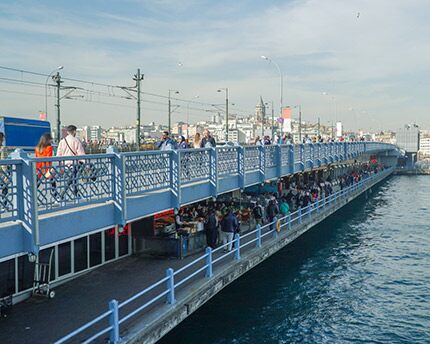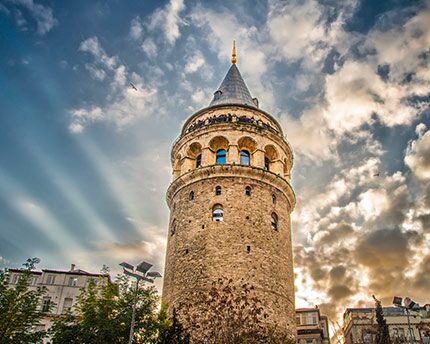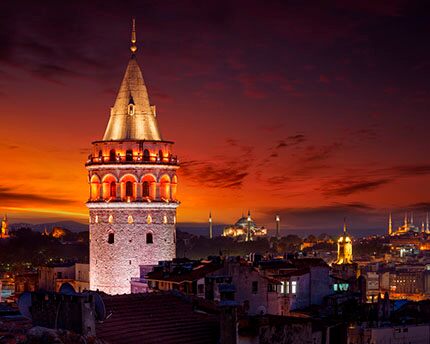Galata neighbourhood
Attractive Galata neighbourhood – officially known as Karaköy – is in the new European zone of Istanbul, separated from the historic peninsula of Constantinople by the Golden Horn estuary. Thanks to its location atop a hill, its main symbol, Galata Tower, can be seen from anywhere in the city so tourists can find the neighbourhood’s streets without difficulty.
The cosmopolitan fame of Galata began in the 13th century when the Republic of Genoa, a participant in the lucrative Silk Route, established one of its main trading colonies here. Just two centuries later, during the Ottoman Empire’s ascendency, this fame was consolidated thanks to the arrival of numerous Jewish communities.
Today, Galata connects central Taksim Square with the historic centre of Constantinople and is also an important tourist attraction in itself. Crossed from north to south by Istiklal Avenue – a main shopping street – the neighbourhood perfectly fuses monumental architecture and bohemian shops. With an atmosphere halfway between splendour and decadence, the steep, narrow streets of Galata invite visitors to stroll around with no particular destination in mind.
Modern Galata Bridge is famous for the picturesque sight of dozens of fishermen and is the most popular entrance for people visiting the area. Once you’ve crossed the bridge, you’re instantly met by Karaköy Market, the best place to buy fresh fish in the city. And as soon as you’re deep inside Galata’s dense tangle of streets, you’ll start to spot tangible traces of its multicultural past. For example, the church of Saint Peter and Saint Paul is a camouflaged Gothic relic of the old Italian citadel, now under the tiles of an Ottoman mosque. And surprising Camondo Steps is a stairway that was commissioned by one of Istanbul’s wealthiest Jewish families at the end of the 14th century. The wavy stairway, beautifully captured by French photographer Henri Cartier-Besson, climbs the hill that sits beneath the neighbourhood and also takes visitors to other points of interest.
This is where you’ll find Galata Tower, which was built in 1348 by Genoese residents; today it has a spectacular viewpoint that looks out over the Bosphorus. The Ashkenazi Synagogue of Istanbul is in an area filled with shops selling musical instruments and is well worth a visit, as is the Jewish Museum of Turkey, which uses panels, objects and photographs to explain the history of the Spanish Jews who emigrated to Istanbul after their expulsion from Spain in 1492, among other aspects. Finally, make sure you stop off at the Galata Mevlevihane Museum, one of the last Sufi monasteries in Istanbul, and a place where the traditional whirling dervish dance is also still performed.
Nearby plans
Related plans

The Galata Bridge, joining cultures in Istanbul
The Galata Bridge is truly a symbol of the city, one of the most significant landmarks for locals and brimming with history and life.

Torre de Gálata, el mirador de Estambul
La Torre de Gálata es uno de los símbolos de Estambul y un magnífico mirador desde donde obtener una de las mejores vistas de la capital turca.

Comida típica turca, más allá del kebap y los baklava
Si hay una comida variada y rica esa es la turca, con clarísimas influencias del Mediterráneo, las cocinas orientales y el mundo islámico en general.


